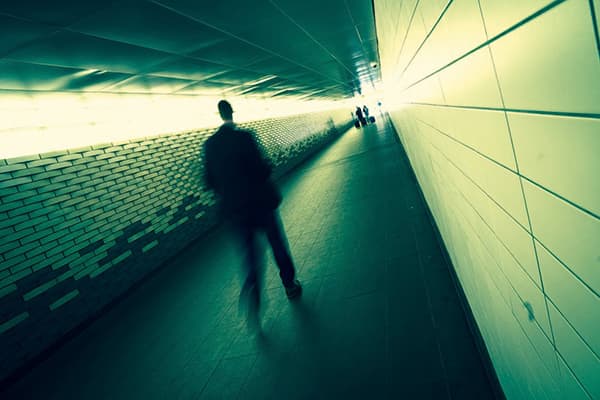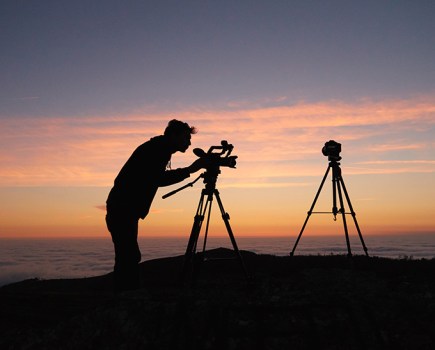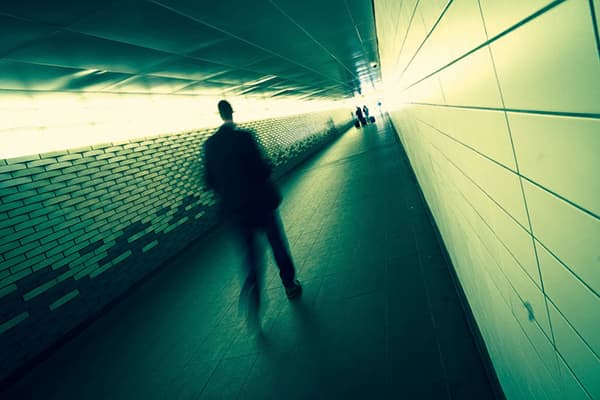
Shooting at 1/8sec has blurred the movement of the pedestrian but the stabilisation system has helped keep the surroundings sharp
From holding their breath to leaning against walls, photographers have lots of tricks for getting sharp images when they’re handholding their cameras. Thanks to technology their images could be sharper still, however. Most camera systems have some form of stabilisation system that’s designed to compensate for those tiny shakes and wobbles that occur when you hold a camera.
If you mainly shoot using wideangle lenses, you might be wondering what all the fuss is about, but pop a long telephoto lens on your camera and it becomes obvious. At very long focal lengths, it can be hard to keep even a stationary subject in the frame because very tiny movements of the camera are accentuated. It’s a feature of the smaller viewing angle of telephoto lenses compared with wideangle optics. A 24mm lens, for example, has a horizontal angle of view of around 74°, but a 200mm lens covers just 10° making a 1° movement of the camera much more significant.
Of course, it’s not just the framing that’s affected; camera movement can also cause image blur. Also, because the movement is more significant with telephoto lenses, the degree of blur is also more dramatic. It’s the reason you should use faster shutter speeds with longer lenses.
Stabilisation systems
The first stabilisation systems for photography were developed for use with film cameras, so they were built into lenses – it’s easier to move a lens element than it is to shift a 35mm film frame inside the camera. Although Canon is credited with introducing the world’s first stabilised interchangeable lens in 1995 (in the Canon EF 75-300mm f/4-5.6 IS USM) and Nikon had the first stabilised lens in a compact camera a year earlier, it was actually Panasonic that developed the first stabilisation system, and it was for a video camera.
The basic principle of a lens-based stabilisation system is that there’s a floating element (or group of elements) that can shift to compensate for small camera movements and so keep the image projected onto the same part of the film or sensor. In practice, it’s a little more complex than having a lens element on a gyro; there are movement detectors that need to determine the magnitude, speed and direction of any camera movement. A microcomputer in the lens then calculates which direction the stabilisation element needs to move, how far and at what speed before relaying this information to the stabilisation unit, which is then moved. This all needs to happen very quickly to be effective and, naturally, some power is required from the camera battery.
The development of digital cameras has given rise to another means of stabilisation: sensor-based. Instead of an element within a lens moving, the imaging sensor shifts to compensate for involuntary movements. As with lens-based stabilisation, sensors are required to detect the direction, speed and magnitude of any movement before the processor can determine the degree of compensation that is required and the sensor can be shifted accordingly.
Greater compensation is required with longer lenses, and usually the camera can detect the focal length of the lens that is mounted to enable it to apply the correct level. If it is unable to do this, it is usually possible to specify the focal length manually via the camera menu.
Olympus, Panasonic and Sony have now started to use both in-camera and lens-based stabilisation together. These dual-stabilisation systems allow the camera to use the most appropriate form of compensation according to the subject and mounted lens. With telephoto optics, for example, the lens-based system offers a wider range of correction. Meanwhile, with macro photography, horizontal and vertical movements are more of an issue requiring sensor-based stabilisation. A dual system means that pitch and yaw can be corrected at the same time as rotational and linear correction.
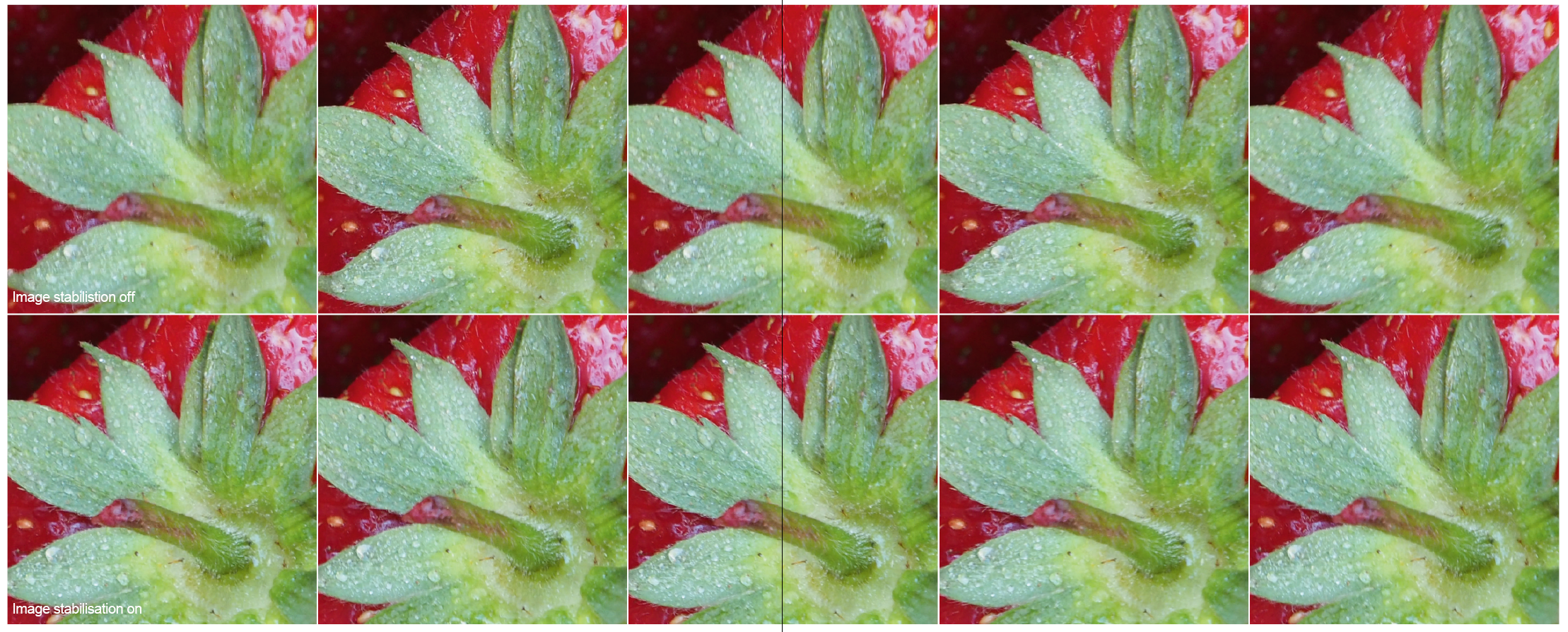
Olympus OM-D E-M1 with 12-50mm lens at 50mm, 1/25sec. The five shots with IS turned on (lower row) are consistently sharper than those without (top row), but are not all equally sharp
Lens-based vs sensor-shifting stabilisation
With SLRs, one of the main benefits of a lens-based stabilisation system is that the correction is visible in the viewfinder. This makes the subject easier to see and the framing more consistent. With early systems, some photographers find looking at the dampened movement can make them feel dizzy but more recent systems are better and give a more stable view.
SLRs have an optical viewfinder so the impact of a sensor-based stabilisation system isn’t visible. Compact system and Sony single-lens translucent (SLT) cameras use the live view feed from the imaging sensor for their viewfinders, so the viewfinder image is stabilised.
Another advantage sometimes claimed for lens-stabilisation is that it makes the camera bodies less expensive and the stabilisation travels with the lens, allowing it to work with any compatible camera. The downside, however, is that the lenses are more expensive and heavier. Manufacturers of sensor-based systems would also point out that including the stabilisation in the camera body means the system is transferable to every lens.
Because the stabilisation element within a lens moves the light path so it may be closer to one side of the iris, there can be a drop in the quality of the bokeh. This doesn’t happen with a sensor-based system, as the light passes through the lens along the normal path.
Although sensor-based stabilisation is very effective, the sensor can only make relatively small movements, limiting its effectiveness with long telephoto lenses. As mentioned earlier, this is part of the reason Olympus, Panasonic and Sony have introduced dual-stabilisation systems that can take advantage of both lens element and sensor-shifting mechanisms.
In 2010, I carried out an in-depth assessment of lens- and sensor-based stabilisation systems and concluded that lens-based systems performed slightly better. Six years on and the tables have turned: sensor-based systems offer more axes of correction.
The pros and cons of the two main types of systems are an academic discussion because each manufacturer has its chosen mechanism. Even where the camera can use a dual-stabilisation system, the photographer cannot usually choose to use one over the other. Also, third-party lens manufacturers tend not to include their stabilisation mechanism when the manufacturer offers a sensor-based version.
Why and when to use it
There are many articles extolling the virtues of using a tripod and lengthy explanations about how to get super-sharp images, but the fact remains that a tripod is still a pain to carry.
Noise control is far better today, so stepping up the sensitivity setting can help keep shutter speeds within a safe handholding range. However, there are still limits, and activating your camera’s stabilisation system is a good way to ensure you get sharp images as light levels fall.
Unless you’re concerned about preserving battery life, I’d recommend you keep your camera’s stabilisation system on for general handheld shooting. Nikon claims its recent Vibration Reduction (VR) system can detect when a camera is mounted on a tripod; even so, it’s wise to turn a camera’s stabilisation system off when it’s on a tripod.
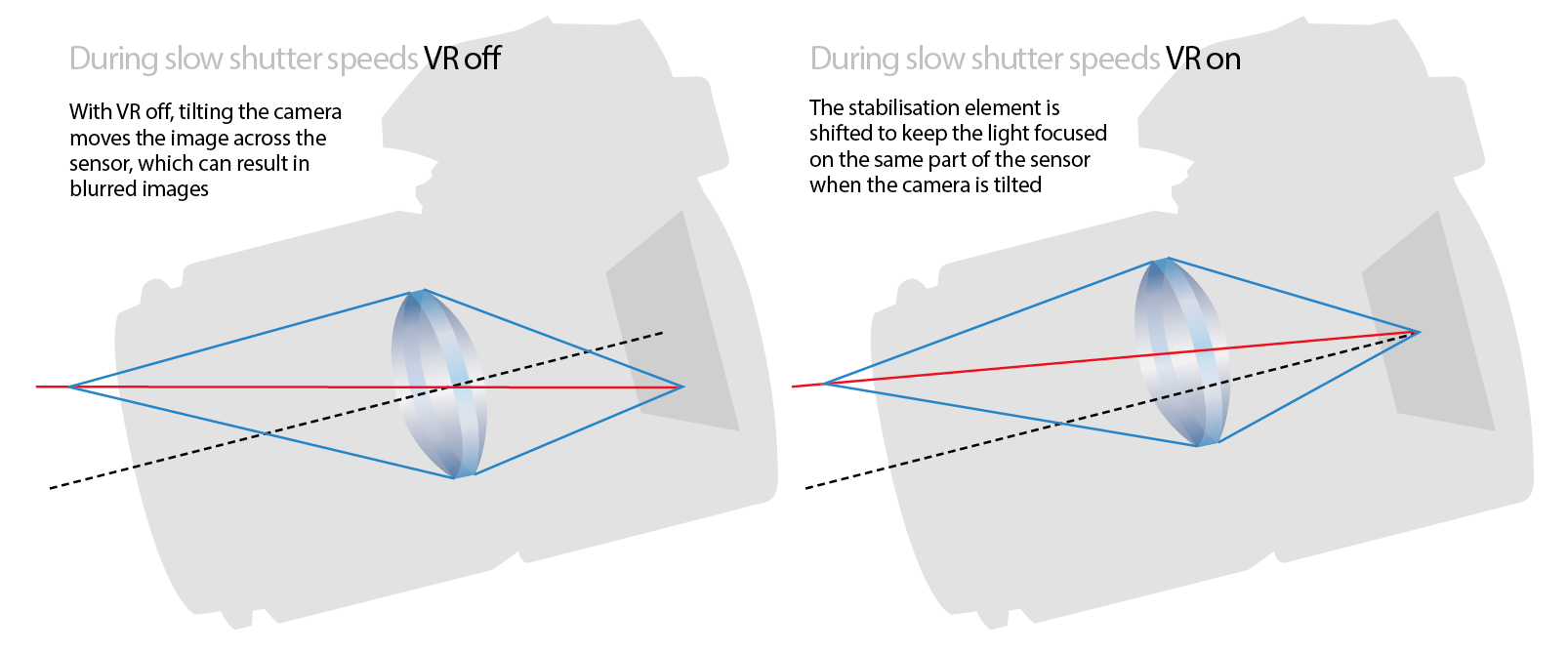
How low can you go?
The general rule for handholding a camera is that you should use a shutter speed that’s at least one second divided by the 35mm-equivalent focal length of the lens. This means that with a 100mm lens on a full-frame camera you should use a shutter speed of at least 1/100sec. With an APS-C format camera you need to take the focal length magnification factor into account and use a shutter speed of at least 1/150sec – making 1/160sec the logical selection if your camera is set to 1/3EV adjustments.
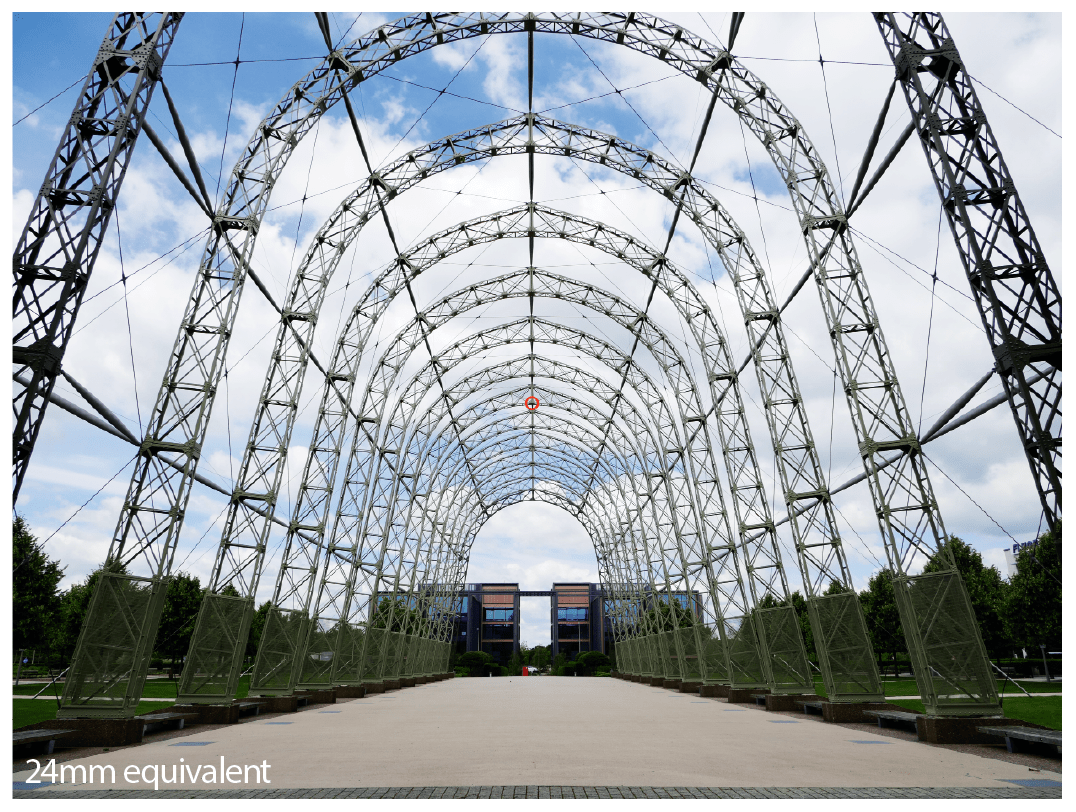
24mm equivalent. The small red circle in the centre of the frame represents a 1° angle of movement
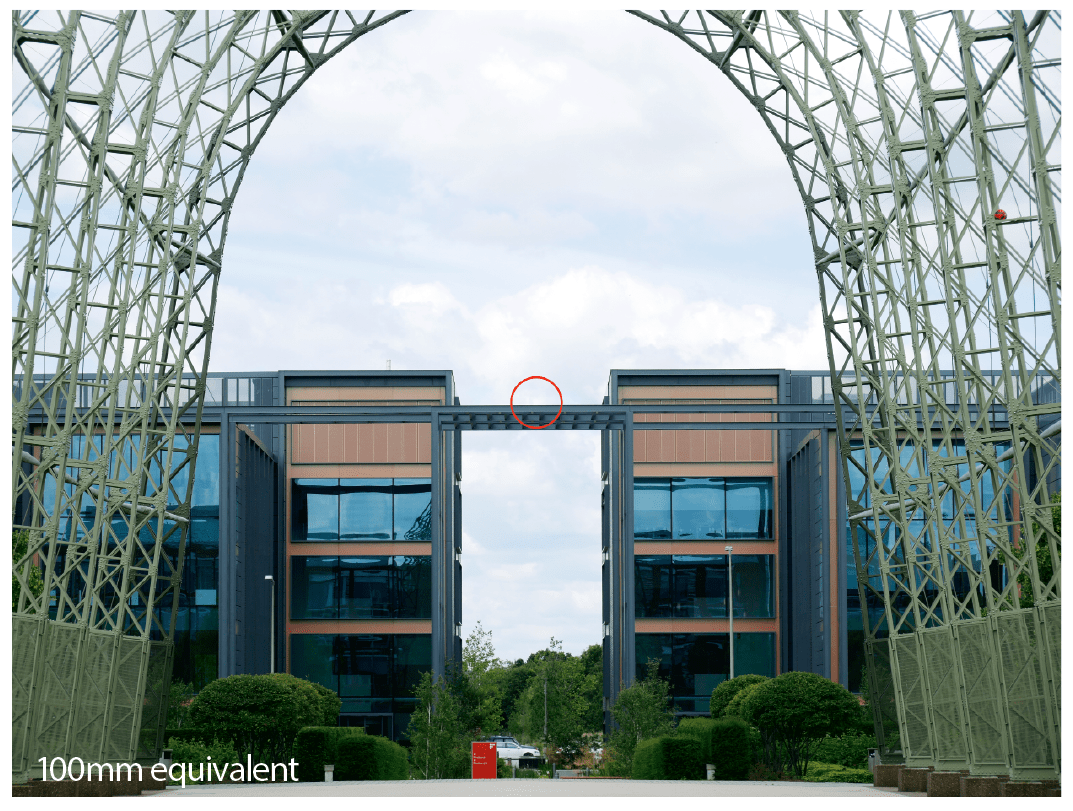
100mm equivalent. At 100mm that 1° angle covers a larger area. This shows how camera shake is amplified by tele lenses
Manufacturers describe the performance of their stabilisation systems in terms of the number of exposure values (stops) that the shutter speed can be reduced below the accepted safe handheld value and still produce a sharp image. Values such as 3, 4 or even 5EV are quoted. A 3EV reduction in the shutter speeds mentioned earlier works out at around 1/13sec with a full-frame camera and 1/20sec on an APS-C format model.
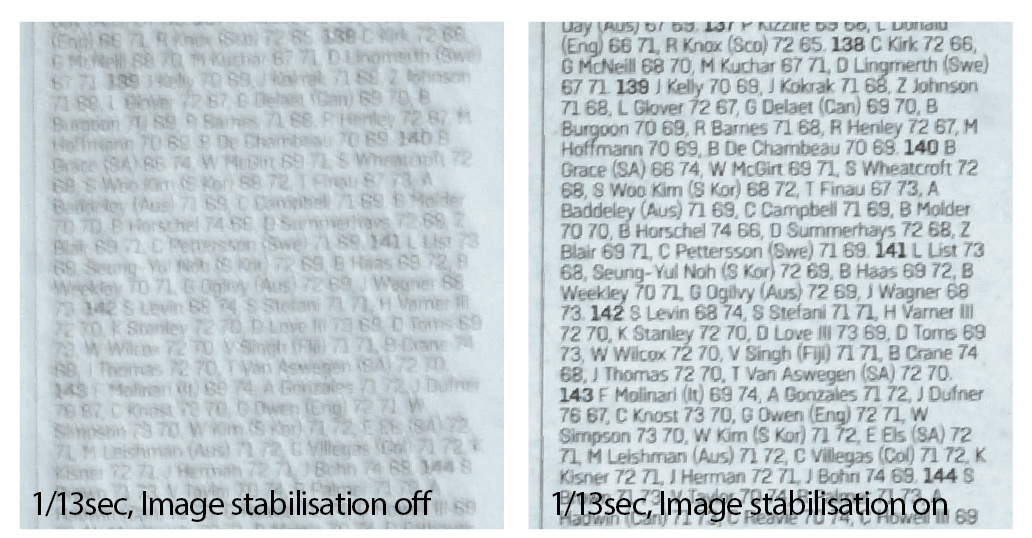
Shooting with the Nikon AF-S Nikkor 80-400mm f/4.5-5.6G ED VR at the 400mm end, I managed
an absolutely sharp hit rate of 2/10 without VR and 7/10 with VR at 1/40sec. Even at 1/13sec I
had a hit rate of 5/10 with VR activated, but dropping to 1/10sec reduced my hit rate to 1/10
However, these performance values are calculated using lab-based measurements – following CIPA (Camera & Imaging Products Association) guidance – with the camera on a vibration plate that’s designed to recreate ‘typical’ camera shake. The actual safe value varies from person to person depending upon a variety of factors, including how much coffee they’ve drunk. It’s worth investigating how low you can drop your shutter speed with and without the stabilisation system active.
Set the mode
Some stabilisation systems offer different operating modes. Nikon usually offers two: Normal and Active. Normal is used for most situations, including panning, while Active is used when shooting from an unstable platform such as car.
A few Canon lenses have three modes but most have one or two. Mode 1 is the general-purpose option, while Mode 2 is for panning with the camera in horizontal or vertical orientation. Mode 3 is available on some recent long telephoto lenses. It’s like Mode 1 but the IS is active only when the shutter release is pressed home fully so that it can apply the most compensation.
Some brands control lens IS modes from the camera, and you’ll have to remember to select panning mode in the menu. A similar rule applies to cameras that use in-body stabilisation, so familiarise yourself with the options and make sure you set them appropriately.
Systems compared
Lens-based stabilisation
Pros
- Works with all compatible cameras
- Correction visiblein SLR viewfinder
- Wider area of correction – good for telephoto lenses
- Bespoke to the lens in question
Cons
- Makes lenses more expensive
- Makes lenses heavier
- Usually works across just two axes
- Bokeh quality can be reduced
Sensor based
Pros
- Works with all mountable lenses
- Works across several axes
- In some cases can work with lens-based systems
- No negative bokeh effect
Cons
- Makes cameras thicker and slightly heavier
- Makes cameras more expensive
- Correction not visible in SLR viewfinder
- Has to work with many lenses
Who does what
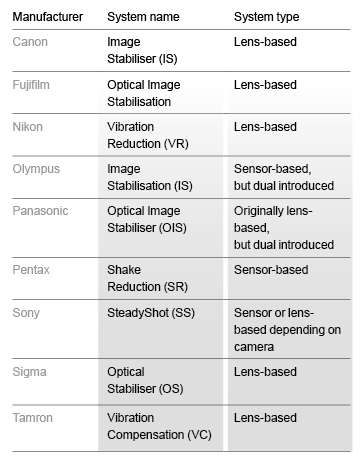
Shake, wobble and roll: the facts
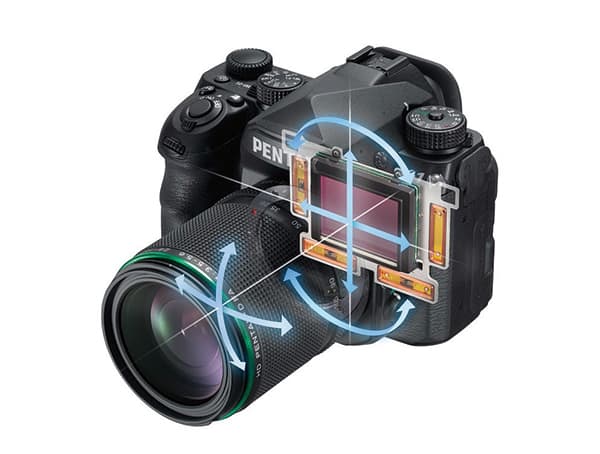
While the first sensor-based stabilisation systems only corrected movements in two planes, the most recent systems from Olympus, Pentax and Sony work across five, but what are they?
Pitch This is an up-and-down tilting or rotational movement as the camera pivots in the hands. It’s most apparent at the farthest end of the lens. It’s a common form of movement with large, heavy lenses, especially after they’ve been held for a long time and the arm muscles start to tire.
Yaw This movement is similar to pitch but it’s a rotational side-to-side shift. Again, lens length and weight are factors. Strong winds can also increase the likelihood of yawing with long lenses.
Roll A rotational movement around the sensor. It can be caused by pressing the shutter release and can be reduced by squeezing rather than jabbing at the button.
Horizontal or X-axis A linear side-to-side movement where the camera is shifted parallel to the subject rather than pivoted around a point. It’s most commonly associated with macro photography, when very small movements can have a major impact upon the sharpness of the image.
Vertical or Y-axis An up-and-down linear movement that’s similar but perpendicular to X-axis movement. It’s also usually a feature of macro photography.
Forwards/Backwards As yet, no system can correct for movement that’s backwards and forwards from the image plane. It’s most noticeable when shooting handheld macro subjects as the slight change in subject distance has a dramatic impact upon focus.

